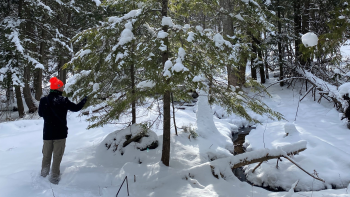| Jan. 31, 2024
Contact: Cheryl Nelson, 231-287-1714
DNR’s new Forest Health Highlights report showcases a year of collaboration, success
 During 2023, the Michigan Department of Natural Resources teamed up with local and federal partners to treat hemlock trees in six west Michigan counties against a tiny aphid-like invader, the hemlock woolly adelgid. During 2023, the Michigan Department of Natural Resources teamed up with local and federal partners to treat hemlock trees in six west Michigan counties against a tiny aphid-like invader, the hemlock woolly adelgid.
The team also has worked to identify and respond to detections of beech leaf disease in seven southeast Michigan counties.
But that’s just some of the work that the DNR’s forest health team did while striving to protect 20 million acres of forest land and urban trees from threats stemming from native and invasive plants, diseases and pests. The issues are compiled in the new “Forest Health Highlights” report, which looks at forest health trends in the state during 2023.
“The DNR’s forest health team works closely with local cooperative invasive species management area groups, or CISMAs, federal experts, researchers and many others to address issues that are new or ongoing,” said James Wieferich, forest health unit manager with the DNR’s Forest Resources Division. “Besides on-the-ground work, the Forest Health Program brings money into Michigan to help partners address forest health challenges and concerns across the state and in many cases, preventing rapid spread of new issues into the region.”
The goal: Keep Michigan’s forests healthy, productive and sustainable. |
Progress is being made against the pest
 The battle against the hemlock woolly adelgid is one good example of the type of teamwork that takes place when Michigan’s forests are threatened. The tiny insect sucks sap from hemlock twigs, and ongoing infestations can weaken or kill host trees. The battle against the hemlock woolly adelgid is one good example of the type of teamwork that takes place when Michigan’s forests are threatened. The tiny insect sucks sap from hemlock twigs, and ongoing infestations can weaken or kill host trees.
That threat means boots on the ground, first to find infestations, then to treat the trees. Over the past seven years, 12,468 acres and 231,429 trees have been treated as part of a strategy to keep the insect from spreading into northern forests. The good news: most of Michigan’s hemlock trees are many miles away from established HWA populations.
Over the past seven years, more than $6.5 million has been raised to respond to the insect, and efforts continue to be funded through the Michigan Invasive Species Grant Program, Great Lake Restoration Initiative, U.S. Environmental Protection Agency, Recreation Passport (state park user fees), fundraising efforts supported by Bob Ross Inc. and other state funds.
The DNR’s forest health team also works with the Michigan Department of Agriculture and Rural Development to respond to recent detections of a similar insect, the balsam woolly adelgid, in Kent, Missaukee and Oceana counties. |
Balsam woolly adelgid also has become a threat
Balsam woolly adelgid poses a threat to the roughly 1.9 billion balsam fir trees within their native range in Michigan’s northern Lower and Upper peninsulas, as well as non-native Fraser and concolor firs. These fir species are important to Michigan’s Christmas tree industry. Producing nearly 13.5 million trees each year, Michigan is the country’s third largest Christmas tree grower.
Balsam woolly adelgid was detected in Michigan in August 2021, when officials at the Michigan Department of Agriculture and Rural Development were notified of several infested Fraser firs in Kent County. No evidence of additional infestation was detected within the survey area, and the eight infested Frasier fir were cut and chipped in winter 2021. Follow-up surveys in late 2022 found no evidence of balsam woolly adelgid in Kent County.
However, in 2023, additional infestations likely resulting from separate introductions were detected in limited areas of Missaukee and Oceana counties. Infestations are currently being evaluated, and treatment plans will be implemented once completed.
You can help
Forest health professionals cover a lot of ground throughout the state, but they can’t be everywhere. The program relies heavily on reports from people who notice unusual insects or sick or dying trees. If you see something unusual or have concerns about trees in your area, use one of these methods to report it.
Note to editors: Accompanying photos are available below for download. Caption information follows.
- Surveying: DNR crews spend winter months surveying for evidence of hemlock woolly adelgid infestation in west Michigan counties.
- HWA ovisacs: This sprig of hemlock shows the small, fluffy white ovisacs – think Q-Tips – that can infect and kill hemlock trees.
|

